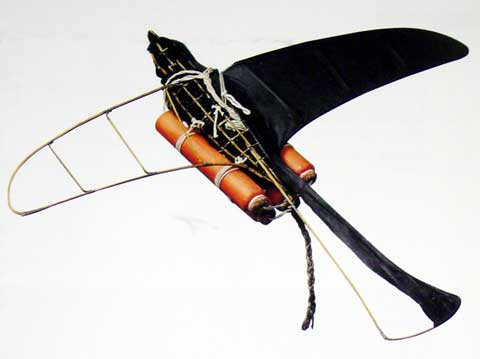
Museum reconstruction model of a Ming dynasty flying bomb
The rocket was not a very effective weapon in its earliest forms, or indeed until well into the nineteenth century if one is being charitable. This changed dramatically in the twentieth century, particularly the second half of the twentieth century, prompting many modern scholars to spend a perhaps unwarranted amount of effort determining when the first rocket was invented, and whether, in fact, the Chinese could once again claim primacy. The Chinese did, it seems, invent the rocket some time in the late twelfth century, and it quickly, in pre-modern terms, spread to the rest of the world. ‘‘Arrows of China’’ are mentioned in Syria about 1280, the ban reached South Asia some time in the fourteenth or fifteenth century, and rockets are mentioned at the Battle of Chioggia in Europe in 1380.
Needham expressed some surprise that Europeans did not make more military use of rockets after they obtained the technology: ‘‘But for some reason or other, probably the early and rapid development of gunnery in Europe, rockets played no great part in warfare after that, being mainly confined to firework displays.’’ At the same time, of course, he also lamented the fact that the evidence for rockets is so patchy because they are seldom mentioned in Chinese battle accounts. Rather obviously, the inaccuracy and limited payload of pre-modern rockets led the Chinese as well as the Europeans to use them mostly for firework displays. It was really only in South Asia, that the ban held a long-standing, if generally ineffective, place in warfare.
There is some difficulty in separating the terminology for fire-arrows from that for rockets, since both could be referred to as ‘‘fire-arrows’’ (huojian). Ironically, the earlier form of fire-arrow, an arrow enhanced with either extra flammable material or gunpowder and ignited before being launched by a bow or crossbow, was an extremely effective weapon in siege and naval warfare. Although the extra weight diminished the range of these missiles, launched in large numbers they could accurately strike many targets. The rocket, by contrast, a missile powered by the gases escaping the aperture of a tube of ignited gunpowder, was unlikely to hit anything it was pointed at. In the unlikely event that a rocket did strike a hostile target, it might inflict some damage with its arrowhead, or with a small payload of gunpowder.
The rocket most probably grew out of the fire-spear, and in this sense, the fire-spear is the ancestor of both guns and rockets. By reversing the gunpowder tube, the projecting fire became a propulsion system instead of a weapon. Although fins and wings were added to stabilize and direct rockets, their trajectory remained erratic. Multiple-rocket launchers were devised to enhance striking power and the likelihood of striking a target, but it is hard to find mention of their use outside of military manuals. Unlike fire-spears and grenades, and even old-fashioned fire-arrows, rockets were hard to use in sieges, and positively dangerous to use on ships (the jet of flame projected back toward the launcher). In the field, they were wholly ineffective against mobile squadrons of cavalry, and only slightly more useful against even massed infantry. Ultimately, what is most remarkable about rockets in pre-modern times is that anyone even imagined that they had a use outside of firework displays.